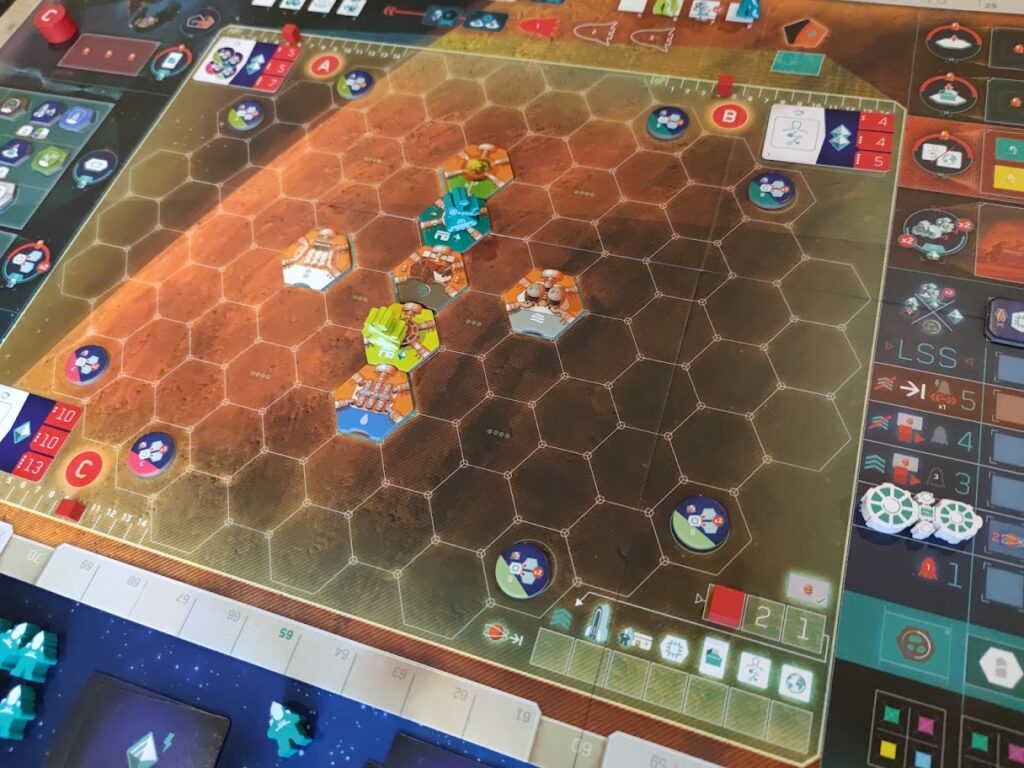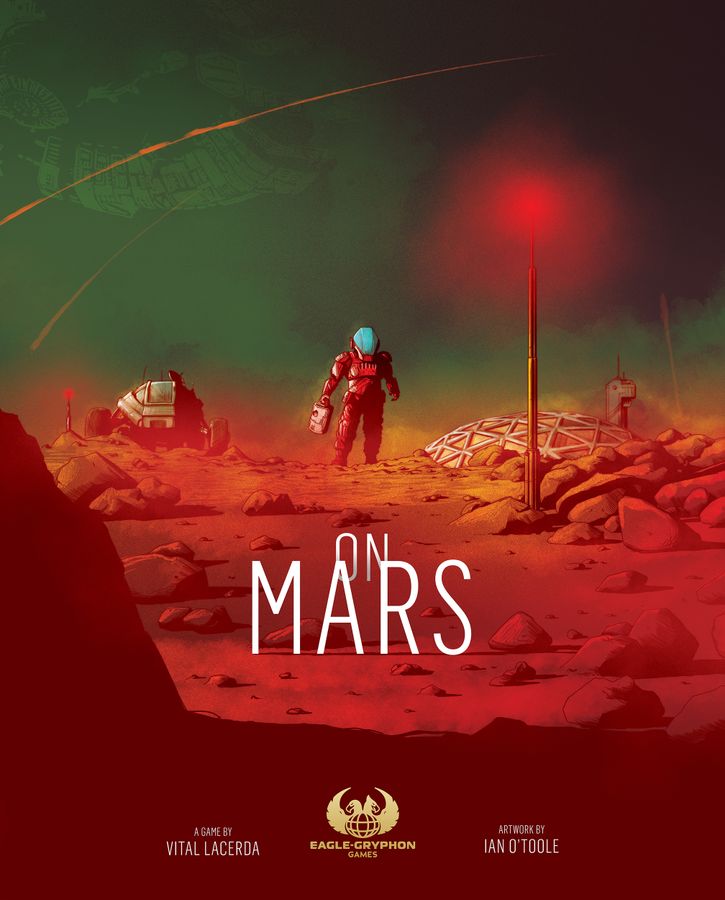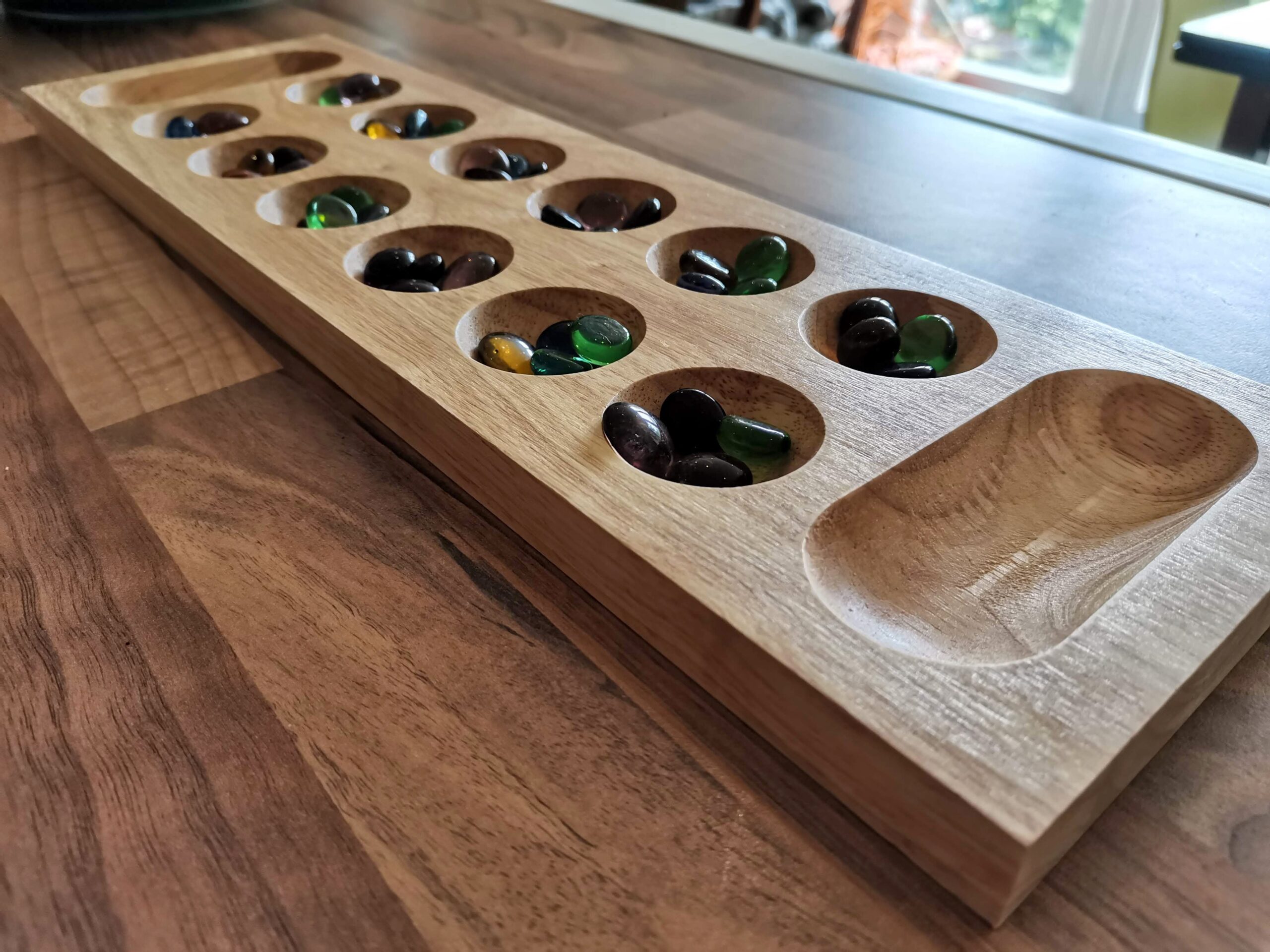On Mars Review

On Mars is from the prestigious tag team of Vital Lacerda and Eagle-Gryphon Games. The partnership is famous for creating lavish, big boxes, with intricate, heavy games inside. Buying one feels like an event, it’s a real treat. It’s like shopping at Lidl every week, then going to do a big shop at Waitrose. As the aphorism goes, though, all that glitters is not gold. So is On Mars a Fabergé egg, or a gilded turd?
Balancing act
On Mars is a science fiction game of colonising Mars, building industry, and making the planet self-sustaining. The planet’s minerals are used to create generators, which fuel the water extractors. The water feeds the plants in the greenhouses, and the oxygen extracted with condensers allows the colonists in the shelters to breathe, and man the mines, which produce the minerals. Repeat ad infinitum.
The reason I’ve taken a paragraph to explain the resource chain in the game, is because of the importance it plays. The dependency of one thing to fuel another is echoed throughout the whole game, and keeping them balanced is vital, and very difficult. A lot of games offer up a huge menu of things to do, giving the players the expectation that they will never be able to do all of them. In some games it can lead to min-maxing, where people forego some things entirely, in order to throw everything at a different goal.

On Mars takes a different approach. Every player needs to do a bit of everything, it’s unavoidable. As an example, the number of each resource you can store is governed by the number of shelters you’ve built. Building shelters requires resources, which you produce by building complexes of buildings. The size of a complex depends on how much its technology has been researched, and research requires resources too.
You can specialise a small amount as the game goes on, but as with much in life, balance is key.
Competition in industry
For the most part, On Mars is a worker-placement game. Certain actions on the board require you to place a colonist on a spot, and there are only three spots available each time. When you consider what I said above, about everybody needing to do everything, you can start to see where the competition comes in. That same feeling of playing Musical Chairs, and trying to be the first to a certain place, also comes on the other main part of the game – the development of Mars.
Much like in Terraforming Mars, you’re trying to build on hexes on the planet. There are strict rules around where you can build, in relation to your growing fleet of rover bots, and trying to build or add to complexes is the name of the game. Managing to do this moves the Life Support Systems tracking pieces up their respective tracks, and there are plenty of points up for grabs for the player that does it best. There’s some real competition for those precious building plots, and you’ll find yourself praying that nobody builds on the place you want, just as you’ll be hoping they don’t take the worker placement spots you want.

Where On Mars really changes things up is in the way it manages who can use which actions. During the game, a shuttle constantly flies between the colony, and the space stations in orbit. Half the actions are available in orbit (things like claiming and researching technologies and building blueprints – the science stuff), and the other half are down on the dusty, red plains, where you’ll build, explore and land rockets. It’s up to you if and when you travel with the shuttle however, so clever players can get themselves out-of-sync with the others. and limit the amount of competition they’re subject to. Later in the game, choosing whether to fly with the shuttle or not can be an agonising decision to have to make, and I love it.
Putting on weight
Martian gravity is around a third of that here on Earth. That’s deliciously ironic, because On Mars is HEAVY. It’s not that taking any of the actions is particularly tricky – they’re actually pretty simple. It’s just the sheer amount of things you need to keep track of at any one time. If you’re one of those gamers who spends half the game staring at their phone, you’re going to come unstuck here.

That weight, and the layers of complexity the game drowns you in, means that there are a lot of people who will hate trying to learn the game. I’d never try to introduce my non-gamer friends to On Mars, because I know they’d have a bad time, and it would be enough to put them off hobby board games for life. The game would be even more difficult if it weren’t for the artist and graphic design brilliance. The iconography is clear, and very easy to interpret, thanks once again to the pen and brush strokes of Ian O’Toole, who also created the artwork for games like Nemo’s War and Ride The Rails.
I get it, I really do. After reading the rulebook for the first time, I was none the wiser, and I’m someone who plays heavy games. I’d never recommend On Mars for anyone whose idea of a difficult game is Stone Age or Pandemic. If, however, you like your games to slap you around the face with choices to make, On Mars is incredible. The sheer number of ways to approach the game is intimidating and irresistible, like a cardboard dominatrix. It’s a hardcore Euro gamer’s wet dream.
Life support
On Mars supports any player count from one to four. The solo game is really nicely done, and it’s very challenging to beat. I recommend playing a two-player game two-handed first, if you’re intending to play solo, because a solid understanding of how the game works is a necessity. There are times when it feels a little unfair, but that’s par for the course when you’re playing a heavy game against some form of automa.

What I find really interesting is how different the game feels with two, three, and four players. This game does something differently to many games of this style, in that it doesn’t block worker spaces when you’re only playing with two players. It limits the amount of resources in the warehouse, and the number of technologies available, but the way it leaves all three spaces open on each worker place means it’s very unusual to feel any kind of competition for space. The same goes for building. It’s very easy to have an unspoken agreement to take half the planet each. It becomes a kind of efficiency race, to see who can pile on the points before the end of game is triggered.
On Mars is best with three or four players. The competition for the turn order spaces, the worker spaces, and trying to control the map of Mars is intense. There’s no real direct player interaction or take-that, but as far as passive interaction goes, this is right up there with the best of them. In some games the turn order doesn’t always feel that important, but it can be absolutely vital here, just like it is in Merv. It feels quite different to play than it does with just a pair of players, and I prefer the experience. The setting of the game is corporations trying to jostle for control of the Red Planet, and that’s what it feels like with more players.
Final thoughts
Tackling On Mars was a daunting prospect. Both in terms of reviewing it, and in just learning how to play it properly. Both have been extremely rewarding exercises though. On Mars is one of the best games I’ve ever played, it’s as simple as that. The way the worker-placement has been merged with a tactical tile-placement game is so polished, and the various mechanisms so beautifully interwoven. One of the things I really like about it is how it manages to do away with the whole notion of collecting piles and piles of tokens, and handfuls of pieces going back and forth. Buying a building costs one resource, upgrading a building is one mineral. It’s actually a very clever piece of game design, because it removes the need for mental maths on top of an already complex game.

There’s no getting away from the fact that On Mars is simply too heavy a game for a lot of people. At the time of writing it’s sitting at 4.65 / 5 on BGG’s weight rating. If you’re absolutely determined to get this game played with your group, make sure you acclimatise them to heavier games first, to get a sense of how much can be going on in a game. Without that, and with a poor teach, it could make for a miserable experience for someone. There’s an excellent rules explanation and how-to-play on YouTube, courtesy of Paul from Gaming Rules! right here.
The variety in setup, with differing personal and combined mission goals, keeps things fresh for plenty of plays. I really like the ability to play short or long games by choosing different types of mission cards. If you want an all-afternoon epic, you can have it, but you don’t have to. It’s not always the sci-fi day-consuming epic that certain other games are. The biggest problem On Mars has is its cost. In the UK at the moment, you’ll have to pay just the wrong side of £100 to pick up a copy, if you can find stock. It’s quite a commitment, especially when you could get a couple of other big name, big box games for the same price. If you’re willing to make the investment though, you’ll be treated to one of the finest examples of rich, thematic, beautifully-produced board game that you’re ever likely own. It’s an incredible game.

On Mars (2020)
Designer: Vital Lacerda
Publisher: Eagle-Gryphon Games
Art: Ian O’Toole
Players: 1-4
Playing time: 90-150 mins











